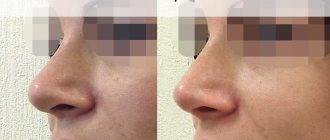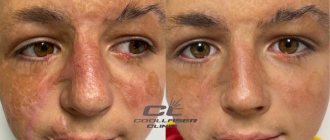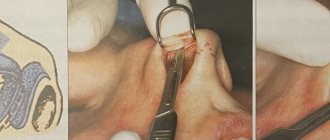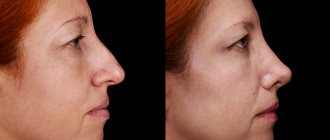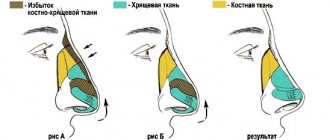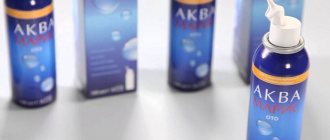Rhinoplasty is a plastic surgery procedure to correct congenital or acquired defects of the nose. With the help of surgery, it is possible to eliminate problems associated with nasal breathing. The procedure can be performed for aesthetic reasons.
After rhinoplasty, the upturned tip of the nose is corrected, also if it has an excessive length or a hump, a saddle shape, or wide large nostrils. There are several types of rhinoplasty, the rehabilitation process after which varies from day to day. Possible use of open or closed method. To clarify the specifics of nasal reconstruction after plastic surgery, make an appointment with a surgeon at the Medial clinic.
How is rehabilitation after rhinoplasty?
Immediately after rhinoplasty, on day 1, the patient needs to stay in the hospital. Nasal discharge and swelling may occur. It extends not only to the nose area, but also to the eyelids. The cast should be removed after approximately 1-2 weeks.
On average, recovery time after rhinoplasty is up to a month. The duration varies depending on the scale of the intervention and the health of the patient, and the characteristics of care. If during rhinoplasty only soft tissues were affected, rehabilitation is 1-2 weeks after the intervention.
When bone is involved, rehabilitation is longer. Sports after rhinoplasty are limited for approximately 6-12 weeks. Whether it is possible to practice boxing after rhinoplasty depends on the complexity of the operation - usually traumatic sports are limited for several months.
For some time after rhinoplasty, you should take painkillers on the advice of your doctor. For a month you need to stop wearing glasses, you can’t sleep on your stomach or side, visit saunas and do steaming procedures. After rhinoplasty, you should not plan trips to the sea until healing occurs.
In the first days after rhinoplasty, hematomas appear in the nose area and under the eyes. Edema may form, which can cause disruption of nasal breathing, and the sensitivity of odors will temporarily decrease.
Alternative to microcurrent therapy
There are other physical procedures for recovery. To speed up the recovery process after surgery, you can use ultrasound therapy. The impact occurs using a high-frequency acoustic wave in the ultrasonic range. Like microcurrents, this procedure has a stimulating, decongestant and restorative effect on tissue. Another option for ultrasound is phonophoresis. This procedure is characterized by targeted delivery of the necessary drugs to the affected area. Light therapy is a time-tested physiotherapeutic procedure. It is produced by a special device that generates light waves of the required length, which have a thermal effect on the desired area. This therapy has a positive effect on blood flow, reduces postoperative swelling, and allows the removal of decay products in the form of toxins and waste.
The first days after rhinoplasty
Many patients are interested in how life will change after rhinoplasty in the first few days. Patients often experience bruising and swelling. What does the nose look like immediately after rhinoplasty? The hue may change to blue-violet, but it disappears in about 2-3 days.
After removing the plaster during rhinoplasty, the blue tint is no longer present and the color becomes natural. Hematomas under the eyes may persist for some time. How long does it take for your nose to breathe after rhinoplasty? For the first three days you can breathe mainly through your mouth. For the first 10 days, a splint is placed on the nose. After its removal, swelling and difficulty in nasal breathing may increase. After the swelling subsides, breathing will resume.
Drug treatment
In order to speed up the decline of swelling, special ointments and gels are prescribed that help resolve swelling and bruises. For example, it could be “Traumel” or “Badyaga”. If the patient experiences a slight increase in body temperature, antibacterial drugs are prescribed. Painkillers are prescribed to relieve pain. It is also recommended to periodically rinse the nose with saline solutions based on sea water - Aquamaris, Aqualor, and so on. They also have a beneficial effect on healing.
Diprospan injections or compresses with Dimexide can also speed up healing and reduce the length of time swelling lasts after rhinoplasty. But doing this at home is strictly contraindicated. All medications can only be prescribed by a doctor. Self-treatment is strictly prohibited. Before using any medications, you should consult your surgeon!
Swelling after rhinoplasty
The operation involves changing the shape of the nose and its size. It is almost impossible to assess the shape of the nose immediately after removing the plaster after rhinoplasty, since it can take several months to take its final shape.
The most common side effect after surgery is swelling. The tissues in the area of the operation are intertwined with a network of vessels, which are injured due to the impact, become damaged and such a reaction appears. Damage leads to bruising and accumulation of intercellular fluid.
How long does it take for the nose to heal after rhinoplasty and when does swelling go down? This is a popular question. This reaction subsides on its own as the tissue heals. However, minor swelling may not subside for several months, especially if a complex intervention was performed involving bones, periosteum and cartilage.
By 2-3 weeks, swelling usually subsides almost completely, bruises and hematomas disappear. The swelling of the periosteum takes the longest to go away - recovery after rhinoplasty can last up to 3 months.
To speed up the healing process, it is forbidden to heat the area, tilt your head sharply, or engage in intense sports.
Causes of edema
Any surgical intervention is accompanied by incisions, and, consequently, damage to tissues and blood vessels at the site of correction. Swelling, bruising, pain and other consequences of surgery are the body’s natural reaction to traumatic external intervention. To stimulate regeneration, fluid accumulates in the operated area, promoting tissue healing. Actually, the answer to the question of how long swelling lasts after rhinoplasty is equal to the answer to the question of how long the tissue takes to heal.
How severe the swelling is depends on many factors. For example, on the volume and complexity of the correction performed. Naturally, the more tissue was affected, the longer the rehabilitation period will be and the longer it takes for the swelling to subside after rhinoplasty. The patient’s age also plays an important role (the older the patient, the slower the tissue healing), the number of previous operations, compliance or non-compliance with the surgeon’s recommendations, and so on.
One week after rhinoplasty
Following restrictions after rhinoplasty allows for a faster recovery. Observation in a hospital is required for 1 day, after which you can return home. The most common symptom after rhinoplasty is swelling. On the recommendation of a doctor, medications are used to prevent inflammation.
The plaster splint is removed approximately one week after the procedure. You cannot remove it yourself without a doctor’s permission. The shape of the nose changes over several months; the result, which is visible immediately after removing the plaster cast, is not final.
Why does nasal swelling occur after surgery?
The fact is that the plastic surgeon makes incisions inside the nose. He peels away the tissue to give the tip of the nose a new shape. During this operation, damage occurs to those same tissues and capillaries. There is no need to worry about capillary damage during surgery. Local anesthesia stops blood circulation and prevents bruising. But after the operation, the tip of the nose is filled with liquid, which is needed for tissue regeneration to occur faster. As soon as the blood supply is restored, the swelling will go away.
Popular questions
Before undergoing surgery, many patients are interested in when they can play sports after rhinoplasty, how to sleep after rhinoplasty, when they can go to the solarium, and how long they need to wear the bandage.
How long to wear a splint on the nose after rhinoplasty?
Tampons or turundas are usually removed after 24 hours. This allows you to breathe a little through your nose, however, due to swelling, congestion often persists for a long time. The plaster is removed after 7-10 days. You should not touch the bandage yourself.
How to massage after rhinoplasty?
Performing a massage is possible only on the recommendation of a doctor after removing the plaster. Patients hold the tip of the nose with two fingers of one hand and apply slight pressure to it, release it and repeat the massage closer to the tip of the nose. This massage prevents the formation of a scar.
When can you sleep on your side?
Increased pressure in the nose should not be allowed after the intervention. For the first few days, it is recommended to sleep with your head tilted at about 45 degrees. You should not touch the pillow with your head; you must sneeze with your mouth open after rhinoplasty.
Is it possible to blow your nose after rhinoplasty?
After about a month and a half, you can blow your nose, but very carefully so as not to damage your nose. It is important not to create excessive pressure.
How long does rehabilitation take after rhinoplasty?
You should wear a plaster cast for about 7 days. The first day you need to wear turundas that fix the shape. They are removed earlier than plaster. The rehabilitation time can be several months - the period varies depending on the complexity of the intervention. When performing rhinoplasty in the summer, it is important to remember that you should not swim, sunbathe, or overheat the area for the first time.
How long do you wear a cast after rhinoplasty?
Immediately after the operation, the patient is put on a fixing bandage, which helps avoid damage. The pad usually takes about a week to wear. The final decision to remove the dressing is made by the surgeon.
How long does it take for the nose to heal after rhinoplasty?
Rehabilitation involves several stages. The patient should wear a bandage for the first 7 days. Swelling persists for several weeks. The final shape of the nose takes approximately 3-4 months. The final result can be assessed in about a year.
Types of swelling
There are 3 types of edema after surgery
- Primary . It appears during the operation, interfering with the surgeon’s work. Knowing this phenomenon, surgeons use special techniques to minimize this swelling. At the end of the procedure, the doctor puts a plaster on the nose and places turundas made of gauze in the nostrils. This is done to ensure that the face swells minimally after surgery.
- Secondary . Usually noticeable only upon closer inspection. Before its appearance, the bridge of the nose widens and the tissues of the tip become denser. This phenomenon is temporary: after 30-45 days, this swelling goes away on its own.
- Residual . Almost unnoticeable: it is felt only when palpating the tip of the nose in the form of a compaction. Dissolves only after 1-1.5 years
Swelling causes the greatest discomfort to people with relatively thick skin - their swelling takes much longer to resolve.
⇒ INFORMATION: Open and closed rhinoplasty: differences and features
RESULT OF COMPLEX RHINOPLASTY
See more “Before” and “After” photos
Degree of development of edema
People who have undergone surgery and are faced with swelling often think about how to eliminate this problem. The choice of an appropriate solution to this problem depends on the degree of development of edema and its type. As with other operations, the degree of swelling depends on the surgical procedure, the length and depth of the incisions, and their type. The complexity of the operation and the features of the procedure determine the location of the swelling, its area, as well as the duration of its resorption.
The degree of swelling of the tip of the nose depends on the type of procedure performed.
- Correction of the wings of the nose and narrowing of the nostrils are less traumatic, and swelling after these procedures is minimal; it goes away in about 6 months
- Removing a hump is a rather complicated operation, the swelling after which is usually pronounced and remains for a long time
- Correction of the tip of the nose is a highly traumatic operation, so the swelling after it is pronounced and does not go away for a long time. After nasal tip plastic surgery, various complications are more likely than after other types of surgical interventions.
The degree of development of swelling of the tip of the nose after the procedure greatly depends on the procedure used. Closed surgery is less traumatic for the body, and therefore there is less swelling after it. Open rhinoplasty, due to the peculiarities of this operation, causes serious fluid retention in injured tissues, which means that swelling is more pronounced.
The degree of swelling is also affected by the age of the patient - this can be judged by numerous reviews. The rehabilitation process in young people is completed more quickly than in older people. The patient's health status, as well as how well he followed the surgeon's instructions during recovery from surgery, also influence how quickly the consequences of nose correction will subside. It is also important to take the preoperative examination seriously, since careful consideration of possible contraindications for intervention will help minimize the degree of swelling in the future.
Why do we choose closed rhinoplasty?
Of course, the type of access during rhinoplasty is chosen exclusively by the doctor and solely according to the indications of a particular patient. Surgeon's tasks:
- carry out a full nose correction
- minimize all traces of intervention.
After closed rhinoplasty, there is not a single visible scar left on the facial skin, since all the incisions are made inside the nasal passages. At the same time, the operation allows you to fully work with the internal tissues of the nose, adjusting their size or shape. This is why surgeons at the GALAXY Beauty Institute choose closed access in the vast majority of cases.
Technique of the operation
IMPORTANT! During preliminary consultations, the doctor discusses with the patient his wishes for nose correction. If necessary, the approximate result of the operation is simulated on a computer.
The operation is performed under anesthesia and consists of several successive stages.
- Providing access. All incisions are made inside the nasal passages. Their location and size depends on the specific task.
- Partial peeling and stretching of tissues.
- Working with nasal structures: resection, suturing, shape correction. If necessary, the surgeon uses pieces of cartilage from the patient's nasal septum as implants. In some cases, when there is not enough cartilage material in the nasal cavity, the patient's ear and rib cartilage can be used as cartilage implants.
- Returning all tissues to their place, layer-by-layer sutures.
- Fixing the nose with a plaster cast.
Technical stages
Closed rhinoplasty includes several stages:
- Skin incisions. Incisions are made on both sides of the vestibule of the nose to access the anatomical structures
- Working on the bridge of the nose
- Lateral dissection of the patient's nasal bone
- Formation of the tip and wings of the nose
- Tamponade is performed
- A plaster splint is placed on top to fix the result.
The length of the partition is reduced
How long does the swelling last?
Doctors warn that it takes a year after rhinoplasty for swelling to completely disappear. Swelling occurs on the operating table and will intensify during the first days.
The swelling reaches its peak during the first week - this can be seen in the photos of clients of plastic surgery clinics. Over time, the swelling will decrease.
It will be possible to remove swelling after rhinoplasty with the help of medications only for a few hours. Be patient - when the time comes, the swelling will resolve on its own.
The main condition for a good result is strict adherence to the doctor’s recommendations. Here are the main ones:
- The swelling goes down more intensely in those who sleep in a half-sitting position.
- Do not touch, massage your face, or use cosmetics.
- Avoid overheating of the body (baths, beach holidays, etc.), physical activity, tilting the head or body down.
In the second period (2-3 weeks), the swelling after rhinoplasty goes away enough to allow the person to go to work and communicate with people.
Recommended:
- Don't sleep on your side or stomach.
- Avoid displacement of facial tissues.
- Protect your face from heat.
- Avoid excessive physical activity.
During this period, in order to relieve swelling after rhinoplasty, the doctor may recommend using the drug Traumeel.
In the third period (2-3 months after rhinoplasty), the nose almost completely gets rid of swelling - only thickening of its tip or back remains. Recovery will be faster if you exclude:
- Smoking.
- Alcohol.
- Pressure on the nose with fingers, glasses and other objects;
- Long bows of the head.
The fourth period (from 4 months to 1 year) is a time when small seals still remain, but they are not noticeable to others. If the question of how long it takes for the swelling to go away from the nose still worries the patient, then the doctor prescribes various physiotherapeutic procedures.
